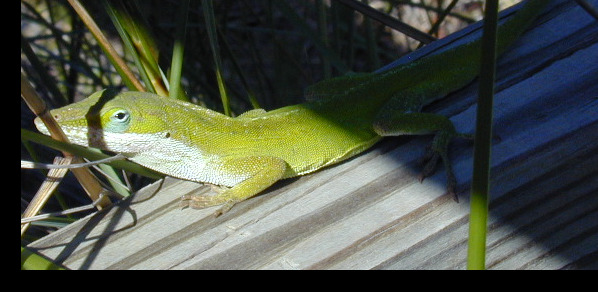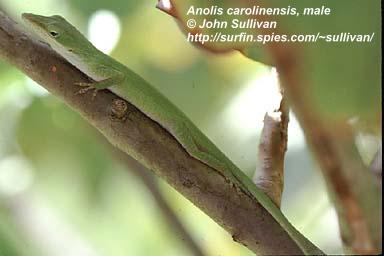|
Name: Green
Anole
HistoryThe Green Anole can be found in many southern United States such as the Carolinas, Florida and Texas. Many of the features of the Green and Brown Anole are very similar with only a few differences. Studies have shown a steady decline in population of the native Green Anole since the inhabitance of the Brown Anole (refer to brown anole page for more detail). These reptiles have a slightly larger head with a longer snout than there close relative the brown anole. The underside of the belly and head are a soft white. Using moveable eyelids they are capable of viewing in different directions. They have small ear openings behind their eyes. The hind legs, nearly twice as long as the front legs, are used for jumping and making these creatures very mobile. Gender is a little more difficult than noticing dorsal patterns. The male has a pinkish throat fan none as a dewlap. Though this is not always viewable this is the most common way of determining gender. Small knots or bumps can be seen on the rear, near the begining of the tail, of the male. This specie commonly referred to as a chameleon, though the Green Anole is not a true chameleon, it can change colors from a pale brown to a more colorful mint green. The color-changing ability of this species allows it to go from mint green to a pale brown. Color change is accomplished by structures in pigment-bearing cells (melanocytes). When the structures expand, the lizard is brown; when contracted they are green. Anoles change color as a function of temperature and mood (hormonal regulation), not to match their background. HabitatAnoles prefer warm climates, they can be found in many different habitats such as trees, beaches and urban areas. Like many other reptiles they enjoy sun bathing on a tree or rock. The Green Anole tends to be found in higher elevations in trees and foliage rather than small bushes and branches. This specie is not as territorial or aggressive as the Brown Anole. When domesticated the daylight temperature should be kept between 75-90 degrees, nighttime 60-70, and basking area 105-110. You should use a full spectrum bulb to duplicate daylight in your terrarium. Ultraviolet light is recommended for 12-14 hours a day during the summer months and 8-10 hours during winter months. The humidity level should be between 70-80%. There habitat should consist of several climbing branches, a basking area and a cool/shaded area. A heat rock should "NOT" be used for the basking area, only some type of heat lamp. Adding live plants to your terrarium will enhance the look of the habitat greatly and will help maintain the humidity. Plants such as pothos, ivy plants and breeds of spider plants will normally thrive in this kind of environment. There are three primary layers that need to be placed in the bottom of the habitat. 1) An inch of small stones and pebbles should be placed in the bottom of the tank for water drainage so that the roots of live plants do not rot and to help aerate the soil. 2) Two to three inches of soil should cover the stones in your terrarium. This provides enough soil for any live plants to grow. 3) Wood chips, Bed-o-Beast, shavings, almost anything natural makes a great bedding to cover the soil. Anoles will do best when kept in pairs, one of each gender (see above "History" for gender distinction). Because of their territorial instincts when two males are kept together in a tank one may become dominant and suppress the other male until it dies. It is a good rule of thumb to keep one male anole per 10 gallons. When putting anoles in a tank it is also best to have anoles that are around the same size. Mixing species is possible but may cause conflicts. You may get away with having different sized anoles and variable gallons per anole. These are just suggested rules that have been stated from terrarium keepers with anoles.
CareSmall insects such as flies, termites, crickets, mealworms, waxworms, beetles and other small insects serve as their diet. Their food should be coated with a variety of vitamin and calcium supplements. Reptocale is an example of a calcium supplement that can be found at a pet store. Place the insects into a zip-lock bag with a little moisture and the powder, shake gently until insects are covered. Pet stores also have special containers that can be used to dust insects. Daily misting, once or even twice, of the habitat should be done to maintain the humidity level and for drinking. Use a spray bottle to mist the walls and the plants in the tank. The anoles will drink water droplets from leaves and from the walls. They will very rarely drink from standing water. Feeding for young can be up to twice a day. For adults 3-4 times a week. During the winter months eating may decrease to only once or twice a week. To maintain a healthy population the enclosure should be kept clean. Any waste products, dead insects, dried blood and other things of the sort should be removed on a regular basis. This will keep the bacteria and infection levels down. A healthy reptile is one that is alert and active. If an anole seems sluggish and non-responsive to an attempt to catch it, it may be an indication of a sick reptile.There are many reasons for reptiles to get sick just like people. Dehydration, unsanitary conditions and a habitat that isn't warm enough can all cause illness. Another cause of sickness could be mites. Mites are a close relative to fleas and tics, they are an eight legged parasite that feeds on its hosts blood. They carry and transmit diseases to their hosts. Once your reptiles have been infested with mites it is difficult to get rid of them. These organisms are very small and maybe difficult to see. Depending on the species of mite, they may be bright red/orange, black or the color of dried blood. Mites roam the body nesting under scales, around the eyes, ears and tympanic membrane. Though they normally do not feed on non-reptiles, they simply use people and other animals for transportation. When an anole sheds its skin it will also shed the mites. Wild caught reptiles are more commonly to be found being a host for mites. When purchasing anoles or other reptiles look for mites on the reptiles and around the enclosure to avoid them all together. Refer to the links, provided from the home page, on the treatment and extermination of mites and other health issues. Stress is also a factor that can be unhealthy for anoles. Take notice to the color of your anoles, when a Green Anole is stressed it will stay pale brown most of the time (Brown Anoles will stay dark brown when stressed). To cold of temperature, insufficient cover in habitat, even a cat nearby watching can stress anoles. Breeding
|



